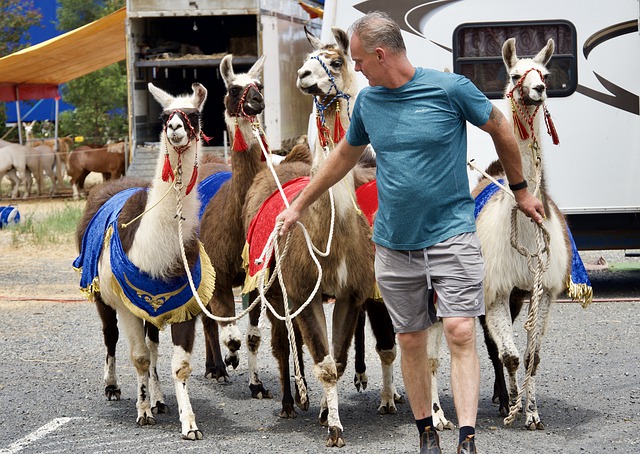Why Lama is an animal like no other?
Description of the llama;
The llama's diet;
The llama and its behavior;
The llama and its habitat;
The llama and its production;
Threats to this animal.
1-Description of the llama:
The llama is an animal of the domestic camelid genus. It is considered the largest of its family in South America. It has a long thick coat, its coloring varies from brown to white and from black to blue. It can also be piebald or spotted.
The llama's legs are equipped with hooves, they are thin and made for movement on stony and steep slopes. When it squats, it rests on its knees and thorax because they are equipped with calluses.
 |
| Description of the llama |
Like its cousins the alpaca, the vicuña, and the guanaco, the llama does not have a hump. Its neck is long and prolonged by a small and rounded head which gives it a slender silhouette.
Its upper lip looks like a hare's beak, it is split. The incisors in spatula, inferior, are protruding. Its ears are short and thin, they curve inwards and take the shape of a banana. Its eyes are marked by long lashes which protect them. The llama's tail is short.
 |
| Description of the llama |
2-The llama's diet:
The llama often frequents the mountains and plateaus, so it feeds on lichen and low vegetation. They also eat roots, grasses, nuts, seeds, and leaves. It prefers to lick rock salt stones in the salt flats. They provide the llama with trace elements that it does not find in bryophytes and plants.
 |
| The llama's diet |
3-The llama and its behavior:
It is a very social and gregarious animal. The llama lives in small groups that are made up of a dominant male leader. The llama's blood is rich in red blood cells and has an oval shape. It has a high rate of blood flow, which is why it can withstand the shortage of oxygen at high altitudes. It often defecates in the same places to define its territory, it forms quite high piles.
 |
| The llama and its behavior:social and gregarious animal |
This animal has a very important ecological role in the Andes, just like an elaphe deer in the forests. The llama grazes on low vegetation, it has hooves that do not damage the natural grasslands. The puma, the ocelot, and the coyotes are the main predators of the llama.
This animal becomes very aggressive when an intruder enters its territory because the llama is simply a very possessive animal. This is why it is used as a guard dog that follows the herds of sheep, horses and goats. He knows very well how to defend and protect them as members of his species by using spits and kicks.
 |
| The llama and its behavior |
4-The llama and its habitat:
The llama is found and lives in the Altiplano which are the mountainous regions of South America. This animal lives between 2,500 and 4,000 meters on high plateaus with alpine vegetation. It is also present in the salt flats and desert areas.
 |
| The llama and its habitat |
5-The llama and its production:
The llama is known for its polygamy, reigning over five to six females. Its breeding season is from November to May. The female can undergo a delayed ovulation after mating. The ovum is released after a period that can go from 24 to 36 hours. The female can have only one baby llama after a management that lasts 360 days. The cria, her baby, weighs 10 kg and can follow its mother just one hour after its birth.
The young is weaned between 3 and 5 months. It will be independent around the fifth month. Concerning the sexual maturity, females and males reach it between 2 and 3 years.
 |
| The llama and its production |
6-Threats to this animal:
The statistical data presented on the llama is false. The number of llamas is estimated to be 3 million, therefore, the animal should not be considered as a threat. Three-quarters of this species comes from Bolivia.
You see, this animal is not at all like the others.

